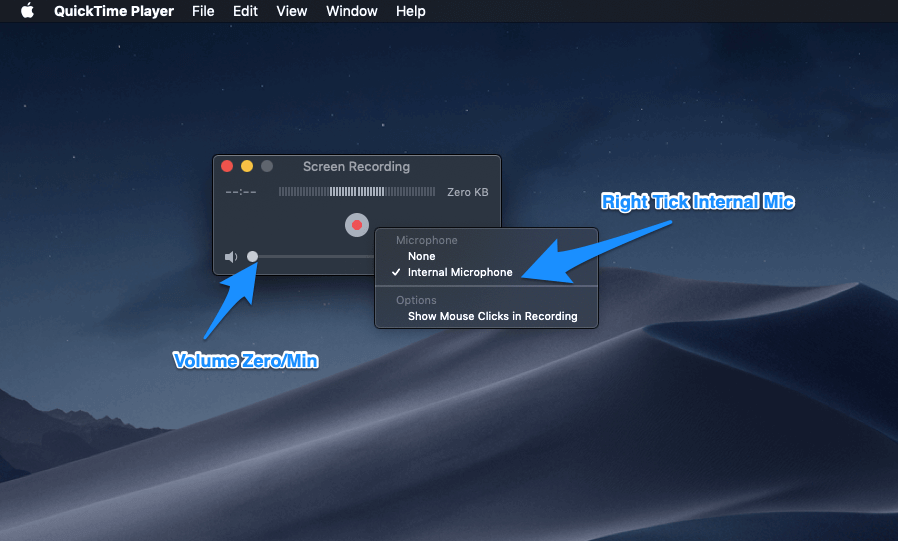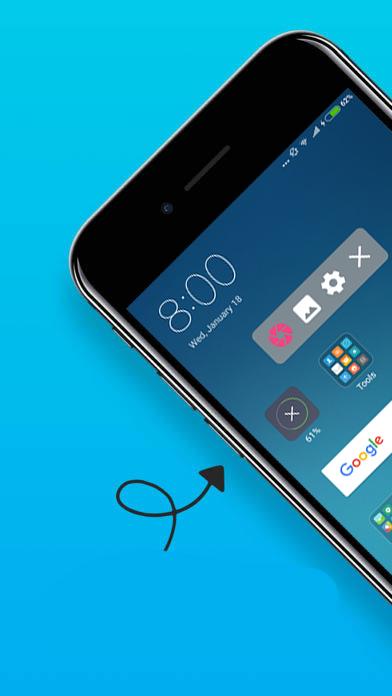Use the Screenshot toolbar
- Record Screen Video And Audio
- How To Screen Record On Mac With Internal Audio
- Screen Record On Mac Free
- How To Screen Record On Macbook Pro With Internal Audio
- How To Screen Record On Mac With Internal Audio
- Click the red 'Record' icon to start the QuickTime screen capture process. Well, you can monitor audio with the volume slider below during QuickTime Player screen recording. If you want to stop screen recording, you can click the 'Stop Recording' icon in the same place.
- Aug 13, 2020 The app cannot record the internal audio of your Mac. For instance, when you try to record gameplay, the software only captures the action on the screen, but not the sound of gameplay. This is where BlackHole: Virtual Audio Driver, a third-party plugin, comes in. BlackHole is not a stand-alone app.
The screen audio recording limitation of QuickTime paves the way for both third-party virtual audio driver and Mac screen recorder with audio. In other words, you have 2 ways to achieve a regular screen.
To view the Screenshot toolbar, press these three keys together: Shift, Command, and 5. You will see onscreen controls for recording the entire screen, recording a selected portion of the screen, or capturing a still image of your screen:
Record the entire screen
- Click in the onscreen controls. Your pointer changes to a camera .
- Click any screen to start recording that screen, or click Record in the onscreen controls.
- To stop recording, click in the menu bar. Or press Command-Control-Esc (Escape).
- Use the thumbnail to trim, share, save, or take other actions.
Record a selected portion of the screen
- Click in the onscreen controls.
- Drag to select an area of the screen to record. To move the entire selection, drag from within the selection.
- To start recording, click Record in the onscreen controls.
- To stop recording, click in the menu bar. Or press Command-Control-Esc (Escape).
- Use the thumbnail to trim, share, save, or take other actions.
Trim, share, and save
After you stop recording, a thumbnail of the video appears briefly in the lower-right corner of your screen.
- Take no action or swipe the thumbnail to the right and the recording is automatically saved.
- Click the thumbnail to open the recording. You can then click to trim the recording, or click to share it.
- Drag the thumbnail to move the recording to another location, such as to a document, an email, a Finder window, or the Trash.
- Control-click the thumbnail for more options. For example, you can change the save location, open the recording in an app, or delete the recording without saving it.
Change the settings
Click Options in the onscreen controls to change these settings:

- Save to: Choose where your recordings are automatically saved, such as Desktop, Documents, or Clipboard.
- Timer: Choose when to begin recording: immediately, 5 seconds, or 10 seconds after you click to record.
- Microphone: To record your voice or other audio along with your recording, choose a microphone.
- Show Floating Thumbnail: Choose whether to show the thumbnail.
- Remember Last Selection: Choose whether to default to the selections you made the last time you used this tool.
- Show Mouse Clicks: Choose whether to show a black circle around your pointer when you click in the recording.
Use QuickTime Player

- Open QuickTime Player from your Applications folder, then choose File > New Screen Recording from the menu bar. You will then see either the onscreen controls described above or the Screen Recording window described below.
- Before starting your recording, you can click the arrow next to to change the recording settings:
- To record your voice or other audio with the screen recording, choose a microphone. To monitor that audio during recording, adjust the volume slider. If you get audio feedback, lower the volume or use headphones with a microphone.
- To show a black circle around your pointer when you click, choose Show Mouse Clicks in Recording.
- To record your voice or other audio with the screen recording, choose a microphone. To monitor that audio during recording, adjust the volume slider. If you get audio feedback, lower the volume or use headphones with a microphone.
- To start recording, click and then take one of these actions:
- Click anywhere on the screen to begin recording the entire screen.
- Or drag to select an area to record, then click Start Recording within that area.
- To stop recording, click in the menu bar, or press Command-Control-Esc (Escape).
- After you stop recording, QuickTime Player automatically opens the recording. You can now play, edit, or share the recording.
Learn more
- The Screenshot toolbar is available in macOS Mojave or later.
- When saving your recording automatically, your Mac uses the name ”Screen Recording date at time.mov”.
- To cancel making a recording, press the Esc key before clicking to record.
- You can open screen recordings with QuickTime Player, iMovie, and other apps that can edit or view videos.
- Some apps might not let you record their windows.
- Learn how to record the screen on your iPhone, iPad, or iPod touch.
Record Screen Video And Audio
QuickTime has screen recording feature, which you can totally depend on for Mac screen capture.
Regardless of your Mac model, desktop or laptop, you must need to record the screen of it for different reasons from now and then. Even you haven’t had such requirement before, knowing how to record Mac screen is also a basic skill that you should master in case under some accidental circumstances, you are not equipped with such skill to quell something.
The simplest way to capture Mac screen is to utilize the macOS-bundled screen recorder whose name is QuickTime. This versatile media player, similar to top-notch VLC, provides screen recording feature to meet the potential video capture needs. With it, you can select any specific region or the whole desktop to record, with audio coming from mic or not. Internal system sound cannot be grabbed due to the copyright and piracy issue. However this is a workaround…
How to Use QuickTime Player to Record Mac Screen
The workflow is quite easy and you can follow the steps below:
Step 1: Open up QuickTime, navigate to File menu on the top toolbar and click “New Screen Recording”.

Step 2: The related screen recording prompt will pop up. For macOS Mojave or Catalina users, a brand-new Screencast app shows up (which can also be called out by pressing Shift-Command-5). While for earlier system users, it’s the QuickTime-style “Screen Recording” control.
Step 3: Define the target recording area through ready-made options (shown below) and mouse. Then set the Microphone source, Save to path, Timer, and others like whether to Show Mouse Clicks or not during recording.
Earlier Screen Recording panel works a little bit different. By clicking the down arrow, you are only given Microphone and Options. Recording region selection is available after tapping the record button.
Step 3: Start and end QuickTime screen recording. Note that the stop button is located in the menu bar.
Step 4: Utilize the thumbnail to trim, save, or share.
Many users get troubled in stopping the QuickTime capture, like they don’t know “how to stop QuickTime screen recording” or the “stop button on menu bar can’t stop recording” exactly. In view of this, you are suggested to try button and shortcut methods back and forth. Below are some shortcut details for QuickTime screen recording on macOS 10.15 & 10.14.
| Action | Shortcut |
| New screen recording | Control-Command-N |
| Open Screenshot app | Shift-Command-5 |
| Capture the entire screen | Shift-Command-3 |
| Capture a portion of the screen | Press Shift-Command-4 to select |
| Capture a window or the menu bar | Press Shift-Command-4 -> Space bar to choose with camera pointer |
| Capture a menu and menu items | Press Shift-Command-4 to choose the menu item with pointer once you opened the menu. |
| Capture the Touch Bar | Shift-Command-6. |
| Stop the Recording | Command-Control-Esc |
Why do Some Screen Recordings of QuickTime Have No Sound?
QuickTime creates no-audio recording is a normal phenomenon, because as is mentioned above, QuickTime doesn’t feature capturing screen with the sound coming from computer. It means, when you haven’t input your voice via Microphone, no matter what’s going on on the desktop, QuickTime won’t record the sound from it at all, unless the volume of internal audio is so high that Microphone has received its signals.
QuickTime offers no way to grab sound from system and built-in apps like QuickTime itself, Skype, WhatsApp, Zoom, Facebook, and YouTube, then how to walk this through? Just keep your patience to move on.
How to Record Mac Screen with Internal Audio?
The screen audio recording limitation of QuickTime paves the way for both third-party virtual audio driver and Mac screen recorder with audio. In other words, you have 2 ways to achieve a regular screen recording with internal audio.
Way 1 – User Third-party Mac Screen and Audio Recorder
Standalone desktop screen recording software comes in handy and is the most recommended way to make screencast. For one thing, screen recorder is more powerful than amateurish QuickTime screen recording by offering more flexible settings and effects. For another, without seeking for any third-party driver setup, the program itself is able to handle audio capture perfectly. Here we take how RecMaster works as the demonstration.
How To Screen Record On Mac With Internal Audio
RecMaster is an easy but slick screen recorder with intuitive interface. It supports any kinds of screen video recordings like game capture, entire screen capture, certain app capture, a fixed area capture, webcam capture and pure audio capture. To help create more engaged and eye-catching footage, RecMaster enables you to superimpose front camera face into screen at any position and size for explanation, to show and highlight mouse cursor for demos, as well as make annotations for instructions. Now please download and install it on your Mac machine for easier screen recording.
Steps on how RecMaster records:
Step 1. Prepare your capture content and open RecMaster for Mac
Step 2. Choose the right mode. When heading over to the secondary window, check and alter the presets if it’s necessary. You are free to customize video format, quality, frame rate, webcam mix, audio source and recording length.
Step 3. Click record button to make the capture happen. Note that the annotation feature will come to RecMaster for Mac soon.
Step 4. Stop the recording. Then play and do easy edits.

Screen Record On Mac Free
Way 2 – Use QuickTime Plus Third-party Audio Driver
Once you install any kernel extension like Soundflower, the extension will route audio from any app to another. Thus, QuickTime is empowered to grab app sound. There are also many Soundflower-alike virtual audio drivers, such as Blackhole and Loopback.
How To Screen Record On Macbook Pro With Internal Audio

How To Screen Record On Mac With Internal Audio
Final Words
All in all, QuickTime player is a nice choice if you are going do some basic recording without internal sound. However, if you are a video nerd and will frequently document screen videos for your vlog, work or so, adopting a decent and affordable application like RecMaster is a wiser choice.

Comments are closed.